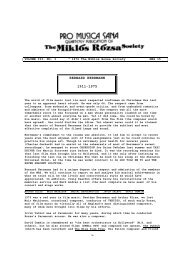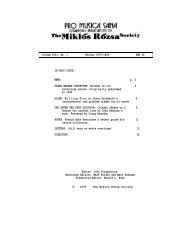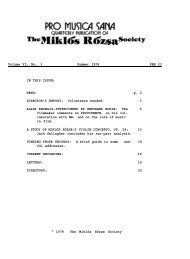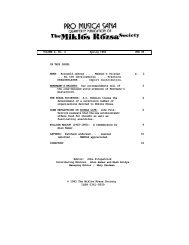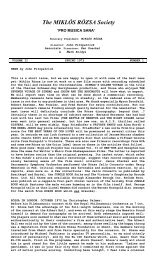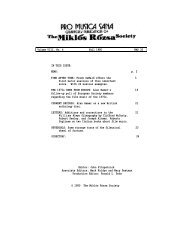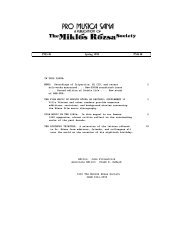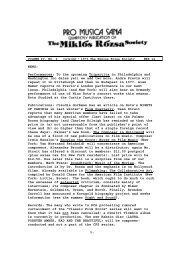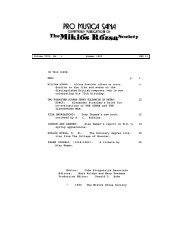The MIKLOS ROZSA Society - Miklos Rozsa Website
The MIKLOS ROZSA Society - Miklos Rozsa Website
The MIKLOS ROZSA Society - Miklos Rozsa Website
Create successful ePaper yourself
Turn your PDF publications into a flip-book with our unique Google optimized e-Paper software.
Of the fence, English Decca will soon be offering BernardHerrmann’s Shakespearean collection and, in February, RonGoodwin’s recording of what he terms the BEN—HUR Suite.Genesis has released a recording of Korngold‘s second pianosonata, and Candide yet another rendition of Much Ado AboutNothing.THE MIRACLE, THE BEST YEARS OF OUR LIVES, and THE BAD AND THEBEAUTIFUL have been announced as future recordings fromFilmusic Collection. SISTERS has yet to appear from Entr’acte(first pressings reportedly were not up to standard), buttheir publication is now available. <strong>The</strong> first issue includesreprints of Film Music Notes articles by <strong>Rozsa</strong> and Raksin(both to be concluded in issue #2), a brief commentary onSISTERS by Royal S. Brown, and other miscellaneous matters. Wethank Main Title for the correction: it was Roy Webb, notVictor Young, who scored the final sequence in THE MAGNIFICENTAMBERSONS.<strong>The</strong> New York City Opera’s Die Tote Stadt will be unveiled inApril, and there is a chance that a recording may soon appeartoo. At least some freshly recorded excerpts have been playedrecently on a broadcast tribute to Korngold on WQXR. But therecording of <strong>Rozsa</strong>’s Cello Concerto in Munich ran intoproblems. It seems that the Bavarian Radio managed to tape thesecond rehearsal instead of the actual performance.Our spring issue will conclude the lecture begun herein andwill also feature the long—awaited <strong>Rozsa</strong> tapeography (to whichany reader who has knowledge of rare recordings is invited tocontribute). Finally we would like to recognize in print whathas been true in fact for some time: that our third director,responsible for membership rolls and correspondence, is MaryPeatman (Mrs. Fitzpatrick), who is a doctoral candidatespecializing in film studies at Indiana University.*A WELCOME NEW CHORAL WORK by Frank DeWald:<strong>Miklos</strong> <strong>Rozsa</strong>’s Opus 34, <strong>The</strong> Twenty—Third Psalm, has just beenpublished by Broude Brothers. It is a brief work (under sevenminutes) but contains a lion’s share of beautiful moments. Itis scored for SATB chorus a cappella. A piano reduction isprovided, but there is no suggestion (as in To Everything<strong>The</strong>re is a Season and <strong>The</strong> Vanities of Life) that it could beused as an accompaniment if needed.2.
<strong>The</strong> work can be arbitrarily divided into five broad sections.<strong>The</strong> generating motive, introduced by the basses is a variantof the opening of <strong>The</strong> Vanities of Life, Op. 30:This motive is developed to a moderate degree throughout thefirst section, which climaxes on the words “for his name’ssake”.A dissonant series of interlocking fourths on the word “Yea”in the upper voices begins the second section, from which thebasses take off on “Though I walk through the valley...”. Thispart continues with much canonic imitation until it cadencesat “they comfort me” on a major chord.<strong>The</strong> third section gets under way with what is essentially ashort fugue. <strong>The</strong> subject:Allegro Risolutois interesting in that it begins in f# minor but cadences in cminor (at which point and in which key the next entry ismade)—a tritone relationship which is quite unexpected andrefreshing. <strong>The</strong>re is no development after the final voice (thesoprano) has entered, but rather a free, primarily homophonicdrive to the closing fortissimo phrase, “my cup runneth over”.A subito pp bridge carries into section four, which introducesa new theme in the tenor:Andante maestoso3.
Note that this melody clearly establishes D major, which isthe parallel key of the opening d minor.<strong>The</strong> last section grows out of the preceding one and is, aswith To Everything <strong>The</strong>re Is a Season, an exuberant Alleluia.Its main motive derives from the tenors’ melody above:Allegro vivoA final allargando brings the work to a triumphant close on aD chord with no 3rd but rather an added 2 nd .As in all of <strong>Rozsa</strong>’s choral writing, there is a free interplayof homophonic and polyphonic textures in this piece. Likewise,harmonies in 2nds and 4ths combine with the more traditionaltertian sonorities to provide a bit of 20th—century“dissonance” - although the work is strictly and completelytonal.From the choral director’s standpoint, the shorter length ofOpus 34 makes it easier to program than either of the twomotets. For this reason it is apt to get a wider exposure thanthose earlier works. It demands quite a bit vocally andmusically of the singer (intonation pitfalls abound), butthere are many above—average groups and college ensembles forwhom the work would be ideally suited. Since Broude Brothersis very cooperative in providing reference scores whenrequested on organization letterhead, I highly recommend thatevery director examine <strong>The</strong> Twenty—Third Psalm for his ownenjoyment and consider its appropriateness for his groups andtheir programs.Incidentally, Broude Brothers also publish an SATB version ofthe “Lullaby” from JUNGLE BOOK. <strong>The</strong> arranger (<strong>Rozsa</strong>) hastreated the three lower voices primarily as instrumentalaccompaniment. This of course is not nearly so effective asthe colorful orchestration in the suite, but vocally it hasits own charm and appeal.*A FLAWED REFERENCE WORK by Frank DeWald:James L. Limbacher’s Film Music: From Violins to Video(Scarecrow Press, 1974) surpasses, in sheer size, any otherfilm music study we have seen. This massive, 835—page volumeis a major addition to our meager filmusic bibliography.Part One of the book deals with filmusic history andcriticism. It is composed of previously published material,mostly from Film Music (later Film and TV Music and Film Music4.
Notes) and Films in Review. <strong>The</strong> 52 articles it contains aredivided into the categories of “<strong>The</strong> Early Days”, “<strong>The</strong>ories andComments”, “Techniques”, “Scoring the Dramatic Film”, “<strong>The</strong>Film Spectacle”, “Classica1 Music on the Screen”, and“Animated Films and Comedies”. Not every article representsthe best in filmusic criticism or commentary, but some of themespecially those by composers writing about their own works,are nice to have back in print. Lamentably, all of the finemusical examples included in the original articles have beenomitted.This part of Limbacher’s book is a thought provokingkaleidoscope of mostly—familiar material, but taken as a wholeit doesn’t provide much of a perspective, and in fact couldleave a reader confused and perplexed. A technique, acomposer, a certain score will be praised here, damned there.Some exorbitant claims and half—truths go unqualified orunexplained. <strong>The</strong>re is a need for something to hold thematerial together (although Limbacher has provided shortintroductory articles for two of his categories).Part two is bibliographic in nature. It lists several thousandfilms, cross—indexed three ways: by title, by year, and bycomposer. <strong>The</strong>re is also a discography section.<strong>The</strong> greater part of Limbacher’s effort must have cone intothis part of the book, but it is only useful insofar as it isaccurate, and there is reason to question its accuracy onseveral counts. <strong>The</strong>re are mistakes evident everywhere. Somefilms are attributed to the wrong person: THE AFRICAN QUEEN iscredited to “Del, Mar”, although an article in the first partof the book says it was composed by Allen Gray (Norman Del Marconducted the Royal Philharmonic Orchestra on the soundtrack).<strong>The</strong>re are inconsistencies: THE TRAP is credited to Ron Grainerin the yearly and composers listings, but to Ron Goodwin inthe discography (Goodwin is correct).Of course in any work of such depth and scope a margin oferror is inevitable. But some of Limbacher’s listings arecurious, to say the least. It seems silly, for example, tocredit Gustav Mahler with four scores dating from 1968 to 1972(DEATH IN VENICE). Richard Strauss is credited with 2001(!!),but not with MUNCHEN. And does anyone really need (or want) toknow that <strong>The</strong> Electric Banana wrote the music for BOB ANDDARYL AND TED AND ALEX (sic)?Limbacher’s composers list includes both composers and“musical directors” but no distinction is made between thetwo, so we find SILK STOCKINGS credited to Andre Previn,although none of his other musicals are listed, And acomparison with Tony Thomas’s limited but considerably moreaccurate listings (Music for the Movies) reveals somesurprising omissions: five of <strong>Rozsa</strong>’s early scores (includingKNIGHT WITHOUT ARMOUR) are missing, as are five by Bernard5.
Herrmann and three by Jerry Goldsmith, <strong>The</strong>re are probably manyothers as well: the Prokofiev and Shostakovich lists are farfrom complete, and even Korngold’s quantitatively modest listis missing three entries (GIVE US THIS NIGHT, THE SEA HAWK,and KING’S ROW).<strong>The</strong> discography section of the book is of limitedeffectiveness. Limbacher has attempted to cover too muchground at the expense of accuracy and practicality. Hedistinguishes between “complete scores or suites (or albumscontaining three themes from a film)” and “other versionswhich are usually single themes only”, but otherwise providesthe record label and number only. Ergo there is no way to tellif a listing is a soundtrack original, a concert version, or aFerrante and Teicher “arrangement”. This type of listing isnot of much use to anyone. A more selective (and perhapsannotated) discography modeled after the one in <strong>The</strong> Techniqueof Film Music would be of greater service to the collector.Certain revisions would make Film Music far more useful andattractive to its potential market. If a second edition couldhe prepared, it should include editorial comments which wouldclarify or put in perspective certain points in part one, andimproved discography, an annotated bibliography, musicalexamples, and fewer errors and omissions. Birth and deathdates of composers would also he helpful, as would labelingeach page of the yearly index with the correct year.A second edition not being likely to appear soon, however, wemust he content with the current effort. Not everyone will hewilling (or able) to shell out the formidable price of $18.50for Film Music, but as a (flawed) reference book it at leastbelongs on library shelves. Why not tell your librarian aboutit?(Ed. note: Several of our readers have already sent lists ofcorrections. <strong>The</strong>se are too long to print here but may he ofsome use to anyone who plans a revision of the book.)*GERHARDT AND HERRMANN by Craig Reardon:<strong>The</strong> latest release in the “Classic Film Score” series from RCAis the best in the series. Gerhardt and Korngold finally havecome around to recording some of the music of BernardHerrmann, the most original composer of film music. Althoughit has been an infernally long wait, the album is amplecompensation. Five superb Herrmann scores are sampled, andplayed with precision under the baton of master Gerhardt,6.
First we have CITIZEN KANE, perhaps the most inventive funscore ever composed, and a landmark in the art of film music.<strong>The</strong> recording consists of a new suite assembled from materialsnot previously culled from the score (i.e., there is none ofthe music heard in Herrmann’s 1943 suite, Welles Raises Kane).All of it is captivating. Curiously, the recording does notalways reveal the musical textures with as much clarity as theoriginal film soundtrack; nor do Gerhardt’s interpretationsquite equal the performances on film under the youthfulHerrmann. However, there is no mistaking that a musical geniusis represented here, in the rich imagination, craftsmanship,and panache of these excerpts. No composer of film music hasever been able to achieve, on the one hand, the kind of dramaconveyed by Herrmann in the Prelude to KANE (not to mentionthe devastating Finale), and then on the other hand, thequicksilver charm or such interludes as the remarkable“Breakfast,” variations, or the exhilarating “Childhood”.Whatever the turns of mood on the screen (and in KANE theywere mercurial), Herrmann’s music reflects them perfectly.Even after two fine suites, there still remains in the scoresuch fascinating music which could be enjoyed separately.ON DANGEROUS GROUND featured a thrilling, climactic chase, inwhich a psychopath was chased up an icy incline, only toplunge to his death. As Herrmann interpreted the scene, thekiller became the quarry, the hunted, and thus the music is arelentless, terrifying “fox” hunt. And, according to themusical expectations of such a situation, the primaryinstrumental voice is the hunting horn. Except Herrmann useseight horns, a far cry from the solo horn heard with mosthunts, and far less genteel. What is particularly exciting isthe way the horns seem to lose all discipline toward theclimax of the piece, and, like a pack of rabid hounds, howl indissonant, quasi—abandon. <strong>The</strong> piece has an almost exhaustingintensity. Aside from music like this, this film scorefeatured a series of pensive, beautiful variations on a simplemotif, played by a solo viola d’amore, designed to depict thegrowing communion between the embittered protagonist (apoliceman) and a young, spiritual blind woman. <strong>The</strong>se alsodeserve to be recorded, because they represent some of themost sensitive passages in film music.BENEATH THE 12—MILE REEF was richly scored. It is a long, fullscore, composed to complement themes of adventure, youthfulromance, and lyrical visual splendors. <strong>The</strong>re are some fineextracts on this record. In one particular instance, note howHerrmann achieves a descriptive effect with the utmosteconomy: an arpeggiated major 7th chord, played by harps, isall that accompanies a diver’s descent into the sea. <strong>The</strong>re isalso, by contrast, “<strong>The</strong> Lagoon”, a watery scene7.
scored with lavish musical expression. On screen, its freeformdevelopment accompanied the underwater cavorting of two younglovers, and the aquatic beasts they see, including a seatortoise and a menacing manta ray. <strong>The</strong> music comments onthese, but never crudely. Much enchanting music for thelovers, plus a heroic, different statement of the main theme,and a thrilling scherzo, still remain to be extracted fromthis colorful score.HANGOVER SQUARE featured a piano concerto which had bothcharacter and style. It still isn’t in the form of a genuineconcert concerto (which generally unfolds in three distinctmovements) but then, neither are any of the dubious filmconcertos, and Herrmann‘s is easily the best of these. <strong>The</strong>dramatic development or the music skillfully reinforced thedenouement of the film, with portions of the work hittingvisual cues precisely. I do not know if this was achieved bycomposing the work first and designing the action to fit, orthe other way around, with Herrmann assuming the conventionalchore of fitting the music to the action. Those who have seenthe film know how the concerto, which plays constantly duringthe last 15 or so minutes of the film, serves its function asa quasi—concert work and as film music. What is remarkable ishow beautifully it plays apart from the visual element, andwith virtually no reworking by Herrmann, other than a fewsectional repetitions. <strong>The</strong> performance under Gerhardt, withJoaquin Achucarro taking the piano part, is excellent.WHITE WITCH DOCTOR further serves to display Herrmann’samazing imagination and facility with the craft. <strong>The</strong> maintitle offers music much more exciting and outrageous than thesort of thing this type of film generally gets. You can hardlylisten to it without leaping around the room. Yet the samematerial, scaled down for marimbas, becomes playful, gentle,and quietly evocative of the same African locale. This suiteincludes Herrmann‘s fascinating musical background of asafari, in which instruments emulate the natural music of theliving jungle, and there is also a delicious “Nocturne”, whichwas originally “love music” in the film. Throughout thesesensuous passages, the scaling of dynamic effects, the use ofrhythm, and the splendid orchestrations are breathtaking andunusual.Physically, this album upholds the quality of previousreleases. <strong>The</strong> cover is particularly clever in design. Inside,Christopher Palmer’s notes are full and well—informed, thoughone might wish that the candid and articulate composer himselfhad been interviewed in the notes. In any event, I for onehope that the producers will investigate other Herrmannscores, for he is unique in that he has never written anindifferent or boring score. What is more, his8.
scores contain very little deadwood; the music always hassomething to say. I hope such classics as FIVE FINGERS, ANNAAND THE KING OF SIAM, THE KENTUCKIAN, PRINCE OF PLAYERS, THENAKED AND THE DEAD, THE GHOST AND MRS MUIR, MYSTERIOUS ISLAND,and others, will eventually be recorded.(Ed. note: Can any reader explain why the newsprint on thealbum cover is in Latin? Or provide a translation?)THE RETURN OF A STREETCAR NAMED DESIRE by Ken Sutak:(This is the second of a three—part series that began in MRS9.)Nothing ever hit like Streetcar. No play, no film, no acting,no dramatic thesis, perhaps not even another title, carried agreater impact prior to its arrival. Nor has that impact beenduplicated, let alone surpassed, since.*This is not to say that Streetcar is the greatest work ordrama ever to grace the American stage, or screen. It is tosay that the artistic event that was Streetcar wasunprecedented a quarter century ago and remains unparalleled aquarter century later.For those of us who can measure all or most of our liveswithin that quarter century, it’s a little difficult tobelieve. We’ve grown up with the vast progeny of Streetcarrather than served witness to the social birth of the parent.So it’s difficult to conjure the particular cultural andartistic environment which Streetcar invaded and immediatelysupplemented.An artistic accretion was inevitable, for pre—StreetcarAmerican culture was an arena dominated by artistic evocationof the hero and artistic analysis of the tinsel commercialsuccess. If the late 19th Century had been stamped by culturalawe of the hero and literary sanction of the puritan ethic asmanifested in business enterprise, the first half of the 20thCentury embraced a vital shift, <strong>The</strong> disinherited among thewriters took the puritan ethic to task for draining the landand its people of their juices: Fitzgerald, Lewis, and DosPassos entered the hollows of Gatsby and Babbitt and Big Moneyand erected limits on the American Dream by detailing theemptiness too often found in the carriage of its extremity. Itwas for a long time a fierce and biting literary land, yet themovies, for the most part, did not join and offered only tacitsanction. <strong>The</strong> movies, after all, were run by men who hadproved the ethic true by success fully feeding dreams to aready public. A Welles could cinematically skin a Kane to thebone, but not often, and never again the box office failed tojump.9.
If the ethic was not to be frontally scarred, the hero was notto be even questioned. For one thing there was no pleasure tohe found in such a pursuit; it was also probable that therewas no profit in it; and it was even possible that there wasno logic in it. For the hero of the land and of the nation’sart was not the hero of fable or fantasy (though that one waswell—liked), but the peculiar 20th Century hero of Hemingwayand Ford and Steinbeck and Hawks, create via artisticimposition of romantic commitment upon realistic enterprise.His roots were unquestionably secure in the experience of thefounders, and if the heirs of the founders could embrace thevery blood of their ancestry and finally rise to bring aHitler to bay while the airs and metaphors of an Armageddonencountered settled upon their shoulders, then his destinyappeared irrebuttably blessed. <strong>The</strong> very greatest of ourartists had sought to teach that courage inheres in allhumanity not merely as potential but as a necessarycharacteristic of humanity, and world events had seemed tosanction the thesis as the end of the first half of thecentury slipped into sight.It was a great and beautiful idea, and it still is. But if itwas the best and most necessary of things to be said aboutlife, it was not all that could be said. <strong>The</strong> late forties weremarked by films, novels, and plays seeking to say somethingelse, yet not knowing quite what else to say in public beyondidentifying social problems against which the art of Hemingwayor Ford seemed strangely irrelevant. Nothing turned thecorner, or even identified the corner, until TennesseeWilliams’s A Streetcar Named Desire appeared.Streetcar scared and stretched the cultural nerves towardpains and exhaustions that seemed almost unknown in art andpossibly overlooked in life. Williams spoke not for thedispossessed or even the defeated, but for the fragile and theweak for whom courage and commitment are tragicallyunavailable senses. Streetcar was very much a cry for pity,and to predicate its plea for mercy it sought compassion bybrutalizing its heroine and its audience. To work dramaticallyas play it had absolutely required, and found, the bravest,most loving of artists to fashion its presentation honestlyand hauntingly. It was instantly and universally received asone of the greatest plays ever written, possibly the greatestever written by an American.Yet considerable temerity was expressed when Streetcarproceeded along that labyrinth of fear, ignorance, andprejudice through which such a play passed into film. <strong>The</strong> filmSTREETCAR is a Hollywood movie made by people who had beenworking in New York, and l949 Hollywood was an arena guardedby the Breen Office and a production code which today has tohe read to he believed. <strong>The</strong> Breen Office at10.
first suggested that a film of Streetcar would be completelyunacceptable under the code. That suggestion was serious stuff- if unacceptable under the code, the film would be denied aseal and thereby cut off from distribution in most Americanmovie theatres.Charles Feldman, then an agent but since STREETCAR a notablefilm producer, decided to make the film notwithstanding thethreat of censorship, and he managed to convince WarnerBrothers to back him. <strong>The</strong> New Yorkers went to work, and so didthe Breen Office. <strong>The</strong> Breen Office insisted that STREETCARcould not pass muster as a film unless its heroine, Blanche DuBois, were presented as a figure no longer in flight fromterrors sparked by the suicide of her homosexual husband. Moreimportantly, the Breen Office demanded that the rape ofBlanche by her sister’s husband - the most vital clement ofthe drama - be removed from the projected film.Elia Kazan, the director, and Williams, the screenwriter, weremuch less concerned about the demand to throw out thereferences to homosexuality than they were about theinsistence that the rape be excised from the drama. As to theformer, Kazan preferred to see it go, and Williams reluctantlyagreed to Kazan’s suggestions that weakness and debilityreplace it. As to the rape, however, both were incredulousthat they should be ordered to throw out the core action ofthe drama. Williams, who had already acquiesced to a score ofminor changes and to one which he viewed as important, wasfinally outraged enough to answer the Breen Office with aletter which has become something of a classic statement ofartistic anguish.“Streetcar is an extremely and peculiarly moral play,” wroteWilliams, “in the deepest and truest sense of the term....<strong>The</strong>rape of Blanche is a pivotal, integral truth in the play,without which the play loses its meaning, which is theravishment of the tender, the sensitive, the delicate, by thesavage and brutal forces of modern society. It is a poeticplea for comprehension.... Please remember, also, that we havealready made great concessions which we felt were dangerous,to attitudes which we felt were narrow.... But now we arefighting for what we think is the heart of the play.... Wewill use every legitimate means that any of us has at his orher disposal to protect the things in this film which we thinkcannot be sacrificed, since we feel that it contains some veryimportant truths about the world we live in.”Those “truths about the world we live in” barely survived theonslaught of the Breen Office, for although the Breen Officeyielded on the rape, it had some strong ideas about how themovie-makers were to handle the aftermath of the rape. In theplay, Stanley Kowalski escapes punishment for the rape. Stellarejects Blanche’s story of the rape and accepts it as thedelusion of her now insane sister. As11.
the play ends, Stella accepts the sensual, and physical,endearments of Stanley as piano and trumpet music of a jazzcharacter suggests Stanley’s elemental – and total – triumph.<strong>The</strong> Breen Office wanted changes in that scene. <strong>The</strong> insistencewas that Stanley be punished, Moreover, since Kazan hadimported his New York composer to Hollywood for the scoring ofthe film, it was clear to the Breen Office that changes in thescoring would have to be demanded. <strong>The</strong> old production codesaid nothing about suggestive music, but the Breen office knewit when they heard it. <strong>The</strong> scoring of the end of the drama was“carnal”; it had to go, and it went.It was a first, of sorts; musical scores had been scrappedbefore, and altered before, and re—written before; but no filmscore had ever encountered censorship problems before.“Carnal” scoring just wasn‘t in the cinematic catalog. As wasto be seen, nor was very much else within the STREETCAR music.Yet what was left after the incidental musical censorshipimmediately gave notice that the film music catalog would haveto be extended. Alex North had arrived.No film composer ever hit like North. Ever. He came to thefilm capital carrying his twin loves of jazz and ballet andhis penchant for trumpets, oboes, flutes, and clarinets andhis incredible ability to make the softest, most piercinglydelicate of commentaries within the high registers of thestrings and his instinct for dramatic understatement and hisliterate insight into the sad and lovely misfits withincontemporary drama. He amazed and impressed virtually everyoneof musical comprehension who experienced his initial filmwork. When that first year in the West had ended he foundhimself regarded as peer by a host of long—established filmcomposers, who immediately accorded him two of the fiveoriginal scoring Oscar nominations voted for that year - afirst for any film composer since the five—score maximum hadbeen set in l916.He didn’t win, but it didn’t matter. He was in company withNewman and <strong>Rozsa</strong> and Waxman and the experience must have beenheady enough. He saw his services being sought again and hesaw his first film music (STREETCAR), then some of hischildren’s suites (Little Indian Drum, <strong>The</strong> City Sings ofMichael) being recorded and released on record. Within a yearhe would be taken under Alfred Newman’s wing, there to watchthe master himself conduct the most talked about score of 1952this side of HIGH NOON (VIVA ZAPATA!) and one of the mostintricately conceived scores ever composed for a throwawaywestern actioner (PONY SOLDIER). By the end of that secondyear he could be reading film reviews crediting the dramaticsuccess of prestigious films to their composer above theirdirector (e.g., Hollis Alpert on ZAPATA).12.
Yet it was not entirely the newest of worlds. For North was acomposer wedded to dramatic concerns almost from the first. Asearly as 1937 he was scoring documentaries (People of theCumberlands), and during the war he had scored several 0WIfilms. His work in the theatre stretched through the ‘40s andincluded his highly praised contributions to the New Yorkproductions of Streetcar and Death of a Salesman years beforehe served as composer of the film adaptations. He’d written aclarinet revue premiered by Leonard Bernstein and the greatBenny Goodman; he’d done a cantata about Nuremberg andcomposed his first symphony; and he’d done a lot of ballet.Most of his work had originated in New York, and both hisintellectual and emotional interest in jazz had been forged inhis youth and nurtured in his maturation there, at Juilliardand within the city’s preoccupation with jazz experimentation.His closest friends at Julliard - the three together, inretrospect, the equivalent of a film music Panzer division -had been Jerome Moross and Bernard Herrmann. Moross andHerrmann had left for California, film work, and eventual filmmusic fame, but North remained in the theatre, in New York.When he did leave, it was at Elia Kazan’s request, a requestwhich followed Kazan’s insistence at Warner’s that North, asopposed to any of the tried and true studio composers, scoreSTREETCAR. North had done some very beautiful, very delicate,very subtle “things” with music for Kazan in the Streetcar andSalesman stage productions, “things” which Williams and ArthurMiller had greatly appreciated, “things” which even thetheatre critics had praised. STREETCAR being quite a breakwith artistic expression in film already, Kazan was determinedto have North transfer his theatrical gifts into cinematicterms, terms which were anything but traditional and whichestablished film composers had never had a requisite occasionto employ - even if they would have done so.What North gave to Kazan and STREETCAR was exactly what Kazanhad hoped for - music which approached its functional purposesnot only as dramatic evocation and informational device, butalso as independent commentary. It was film music of the veryhighest order, music which shows an audience what is happeningwhen the screen action itself does not always reveal itsmessage or menace, yet music which goes beyond that functionand adds its own voice to the comments and cares of otherparticipating artists. It was a confrontation with thematerials of masterpiece which itself stood within its mediumas a masterpiece. It was the score which had to be written forSTREETCAR - music intended to show the bleeding within thefilm and, with the film, music aimed at the jugular and thenthe heart of any audience shown the devastation. Finallybuilding to a subjective act in13.
itself from a base of purely objective musical implications,North’s score tore at an audience - it seared the heart andbegged compassion of the intellect simultaneously.For North, perhaps no other musicalization was possible. <strong>The</strong>composer’s body of film work is rich enough today to supportthe inference that North is a composer for whom love of musicis not enough. North is a composer who says things with musicwhen the vehicle necessitates and/or allows commentary. Youmay write a revue for clarinet and orchestra because you lovethe clarinet, but you do not write a cantata about Nurembergunless you have something to say. You may write children’ssuites and ballets out of love of making music and sharing itwith gentle and vibrant spirits, but you do not give thirteenmonths of your life and the zenith of your musical ability toSPARTACUS unless you share its thesis and goal and elect to beremembered for their presentation, You can alternate the studyof symphonies with writing for the best of the jammers in ajazz showdown because it’s serious business and pure fun atthe same time, hut you do not take your intricate knowledge ofboth worlds and unite them in one work so as to lacerate,seduce, pain, and finally break the ear and heart of youraudience unless you have addressed your intellect to animportant truth and have determined to roach with that truththrough your own medium the intellects and nerves, visions andcomprehensions of your audience. That is the path taken by thebest of artists, the election of the brave and committed, foressentially it is the most gentle and loving of gifts offeredby Hemingway’s brave, and the most necessary and expensive ofrecognitions implored by Williams‘s fragile survivors.<strong>The</strong> poet would have called it an embrace by blood of beauty.Be that as it may, it was certainly an embrace, and surely anembrace so giving and so rare as to be deservedly cherished,Yet at the peak of the Golden Age of Film Music its directionwas so unique and its success so total that the score was notmerely cherished but also institutionalized, held forth as abeacon by which the golden agers of film music confronted andmerged with a new wave in film music expression. And in thereflective aftermath of those moments of its most decisivecultural impact it seemed to offer more than a hint of beingthe most important film music event since Bernard Herrmann hadimplanted what Oscar Levant called “an apprenticeship ininsolence” within the musical language of the film art, for itinitiated and heralded a new era in film music not with eithera whisper or a hang, but with the apotheosis of both._________________________* A detailed account of the confrontation between the makersof STREETCAR and the Breen Office is provided by Murray14.
Schumach in <strong>The</strong> Face on the Cutting Boom Floor, published byWilliam Morrow, 1964 (New York). <strong>The</strong> emphasis, of course, ison the film, which the author views as the most importantmovie ever made insofar as the subject of censorship isconcerned.(To be continued...)<strong>MIKLOS</strong> <strong>ROZSA</strong>: LECTURE IN LONDON (Oct. 1972):(Ed. note: This is the first of two parts. Our thanks onceagain to Craig Reardon for transcribing the recording.)<strong>The</strong> program begins with a film clip from EL CID.Alan Warner: This afternoon we welcome you to another lecture,and we have with us a very distinguished gentleman. Twoweeks ago, <strong>Miklos</strong> <strong>Rozsa</strong> took part in the Filmharmonic concertat the Royal Albert Hall, and this afternoon he has come totalk with us about his very long and distinguished career infilm music, He’s been nominated for over 16 Academy Awards,and on three of these occasions he won the Oscar himself.Ladies and gentlemen, Dr. <strong>Miklos</strong> <strong>Rozsa</strong>. (Applause) How did itall start? Did it all start in 1935, back in London?*<strong>Miklos</strong> <strong>Rozsa</strong>: It did. I was living at that time in Paris,minding my own business, and had absolutely no idea aboutfilms, let alone music in films. But I came to London to writea ballet for the Markova—Dolin company, which played here -and I love London and I stayed here. About a year later, 1936,I read in the papers that a friend of mine, Jacques Feyder,was in London, and I knew him very well from Paris, and I justcalled him. He lived at the splendid hotel which was oppositeGreen Park - it does not exist any more - and he said, “Willyou please come to my hotel right away, I am in deep trouble”.Well, I jumped into a taxi, I ran to the hotel, and I said,“What’s the trouble?” And he said, “My laundry. I can‘t tellthem in English what is laundry. <strong>The</strong>y don’t know to take itaway.” Well, my English wasn’t quite perfect, but I knew whatlaundry is, and his laundry was taken away. He said, “Well,let’s go have dinner”. I said, “I’m sorry, but I have to go tomy ballet”. And he said, “Can I come with you?” He did, and hesaid, “Now we’re going to celebrate, and I invite you toGaulino’s. And we had supper, and he ordered champagne. Herather liked the champagne - I never drank it before. And, asthe evening went on, and the champagne went down M. Feyder‘sthroat, my stock as a composer went up. And at the end of it,Beethoven was somewhere back in a corner, and I was thegreatest composer of the world. So he said — and who was I todisagree with him, anyway — ”Why don’t you write the music formy film?” And I said,15.
“Well, you’re very kind, but I don’t write fox trots.” And hesaid, “I don’t want fox trots, I want serious music! My wife,Francoise, is coming from Paris, and we’ll have lunch tomorrowand talk about it.” Well, I took him home. I was sure He‘dforgotten the whole thing, but lo and behold, ten in themorning the telephone rang and he said, “Francoise is here; weare expecting you at 1:00 at the hotel for lunch.” I wasthere, l:00 exactly, sharp, and both were very charming, andthey said, “She’ll be here any moment”, but I didn’t know whoshe was. I didn’t dare ask. It was 1:30, 2:00 — no lunch.2:30, and suddenly a lady and a gentleman came in. <strong>The</strong> ladywas extremely well-dressed — very elegant, very beautiful —and the gentleman was her husband, and they were introduced asMr. and Mrs. Sieber. Both had a German accent, so I said, “Howdo you do” with a German accent. And we sat down for lunch andI noticed all the waiters around are looking at us. Now, Iknew that my ballet was playing and it was extremely famous inLondon, but I wasn’t used to this kind of attention. I noticedthen that they were looking at the lady next to me. Well,suddenly she turned to me and said, “Is my song ready?”. And Isaid, “What, a song?” I didn’t know what song! Feyder cued meto respond, so I said, “Oh, the song! Well, it’s not ready butI’m working on it.” And I turned to Feyder and I said, “Who isshe?”. And he said to me, stage whisper, “Idiot! MarleneDietrich!” So I looked at her, and indeed she was! Well, whenthis was over, Feyder said, “She likes you; now we go to seeMr. Korda”. And I say, “Who is Mr. Korda?” He says, “You are ahopeless situation, but for now just shut up, all right?” Isaid, “All right, that’s very easy”. We went to the studio andhe said, “First we are going to have tea with the brother ofMr. Korda, Vincent Korda. You know him?” I said no. “Well, heused to live in Paris; he was a painter.” So we had tea, andVincent Korda — who is here tonight — was looking at me, hisbig eyebrows like this. He didn’t address one word to me. Atthe end he said, “Are you a Hungarian?” I said yes, and thatwas all. <strong>The</strong>n Feyder said, “Now I’m going in to see Korda; yousit down; be right back.” And now, later, he came back andsaid, “Congratulations, you are engaged.” And I said, “Well,how? What did you do?” He said, “Well, I went to see Korda andI said, ‘I want <strong>Rozsa</strong> as my composer!’ He said, ‘Who’s <strong>Rozsa</strong>?’And I said, ‘Who’s <strong>Rozsa</strong>! You mean you don’t know? This is thebest friend of your brother Vincent! <strong>The</strong>y practically livetogether in Paris! And Alex Korda said, ‘I want Spoliansky.’Feyder said, ‘I hate Spoliansky; I don’t want him!’” And thenFeyder told me, “Who is Spoliansky? I never heard his namebefore!” Well, anyway, that’s how it all started, ladies andgentlemen. <strong>The</strong> film was KNIGHT WTTHOUT ARMOUR, with Marlene16.
Dietrich and Robert Donat, and I started with Mr. Korda, laterSir Alexander, and he took me to Hollywood — he, rather,exported me to Hollywood in 1940, to finish THE THIEF OFBAGDAD. This is the beginning of my story of my film life.A.W.: Just going back to KNIGHT WITHOUT ARMOUR, how in factdid you come to terms with scoring a major feature? <strong>The</strong> firsttime?M.R.: Well, to tell you the truth, I had absolutely no ideawhat to do. I had to write a song for Marlene, which, it’suseless to say, was never used in the film. It was never evenrecorded, but I had to write it, and slowly I bought two bookson Tottenham Court Rd. <strong>The</strong>re was an antique shop and there wasone German book and one Russian translated into English aboutthe technique of film music. And everything I learned fromthese books was absolutely wrong! But then, finally, westarted and I had long conferences with Muir Mathieson, whohad been the musical director for Mr. Korda, and somehow Ilearned it.A.W.: Since you got into the Korda part of your career rightaway, probably we should have a look at our clip from JUNGLEBOOK.M.R.: I would love that.Film clip: <strong>The</strong> closing scenes and end title from JUNGLE BOOK.A.W.: Those in fact were Vincent Korda sets, weren’t they?M.R.: Yes, I think whatever you have seen here was designed byMr. Korda, of whom I spoke before. If he is still here, willhe please stand up for a moment? I saw him — well, we’ll catchhim!A.W.: Moving to the other brother, just how demanding wasAlexander Korda?M.R. Alexander Korda was a great man, and a great man becausehe knew how to delegate power, He knew very little about music— he was not a musician — but he knew the value of music. Andonce he trusted somebody, you could do whatever you wanted.A.W.: Could you briefly describe your days at Denham with MuirMathieson?M.R.: Well, it was a wonderful time, because we were bothyoung. We are not young any more — this is the trouble! Muirwas conducting and I was writing the music, and Mr. Korda wassupervising. For a short episode, I would like to tell youabout Mr. Korda, which I think characterizes him very well. Idid FOUR FEATHERS for him, which he liked, and he said, “Weare going to do a picture called THE THIEF OF BAGDAD, which isan Oriental fantasy, and is all based on music. Would you liketo do it?” And of course I was delighted. I was engaged. Andabout 2 weeks later he told me he was in trouble. He has adirector, a German director, and the German director insistson an Austrian opera composer — I can mention his name becausehe’s dead now for a long time, Oscar Straus - to write themusic, because17.
he worked with him on an operetta film in Paris. Korda told meit is very much against his wishes; however, he says to startthe film; he has to please his director. He said, “Would youtrust me?” I said, “Undoubtedly”. So Mr. Straus started tocompose music for the film. He was in Vichy, in France, andsending us the music. Well, the music was typical late 19thCentury Viennese opera stuff, which did not belong to a THIEFOF BAGDAD. And I couldn’t say a word; I was still trusting Mr.Korda. Rut Muir Mathieson, being a hot—headed Scotsman, wentaround telling everybody the music stinks to high heaven! Andone day we are at tea with Mr. Vincent Korda, and he asks us,“How’s the music?”, and Muir let loose. A day later, we weresummoned into the presence of Alexander, and we arrived 10:00in the morning in the studio, and it was gloom in Denham. Asecretary told us, “I don’t know what’s eating him, but he’scertainly not in a good mood. Go right in.” Well, we enteredpractically in the same manner as Louis XVI entered the placewith the guillotine. And there was the director of the film,smiling, and Mr. Korda like a Greek god, sitting behind hisdesk, looking up behind his glasses, and he said, “BOYS!” Nowthis was already bad, you know — we were very young, but weshouldn’t have been addressed as boys. He said, “Boys, I hearyou are making criticisms against the music of that greatmaster, Oscar Straus.” Well, Muir Mathieson again lost hishead and he told him what he thought about that music. AndKorda — said, “Wait a minute! Dr. Berger” — that was thedirector, who is also dead — ”is in charge of every artisticquestion in this picture, and you have to obey! That’s all.”Well, Dr, Berger smilingly went out, Muir Mathieson, you know,holding his fists like this, went out, and I went last. I wasjust at the door, when I felt that Mr. Korda was pulling mehack. He said, “How‘s the music?” I said, “This is operettamusic for a Viennese stage.” He said, “I know, but there‘snothing I can do; he has to go on. However, now you go home,recompose everything, but don’t say a word to anybody, noteven Muir Mathieson. Promise?” Promise. “When you have it, letme know.” Two weeks later, I recomposed the whole stuff. Icalled him and said, “I have it; do you want to hear it?” Hesaid, “No — I give you an office next to Dr. Berger’s. Youplay your music day and night!” Well, I was there 9:00 in themorning. Three days went by, and I played my music. I knew itby heart, back and forth, and I played it — and loud. Nothing.<strong>The</strong> fourth day, suddenly the door opened, and there comes Dr.Berger, and he said, “What on earth are you playing?” And Isaid, “Well, I just had some Ideas for THIEF OF BAGDAD, that’sall.” “Play it again!” So I played it. Went up and down, said,“Play it again”, so I played it again. He said, “Wait, don’tleave; I’ll be right hack.” He ran to Mr. Korda and said hediscovered me. He said, “This18.
is bettor than Straus’s music, at least for the picture”, andthat’s the music he wants. And I had to go to Mr. Korda’soffice with him, a twinkle in his eyes, and he won the game.Now, this is like a chess player, who knows ahead the steps ofhis opponent. It was absolutely incredible that this was aplan, you know, to get me in! Not to hurt the man’s feelings —and get me in the picture. So, that was the story of THE THIEFOF BAGDAD.A.W.: I think we ought now to hear the scherzo, which was theFlying Horse sequence.M.R.: Well, this was just a short sequence. I don’t know ifyou have seen it — I don’t know if you are old enough to haveseen THE THIEF OF BAGDAD — but there were many fantasticthings in it, one of which was a flying horse. <strong>The</strong>re was anold sultan who’s presented with a flying horse by a magician,and I wrote a gallop — a very gay, short piece of music — andthe picture was done to the music. So, I want to emphasizethat when we come to talk later about the aesthetics of motionpicture music, sometimes it helps that the music guides, givesideas, to the men who do the actual visual part of the motionpicture. So this is THE THIEF OF BAGDAD, the Flying Horse —with Miles Malleson as the Sultan.Film clip: THIEF OF BAGDAD, the Flying Horse sequence.A.W.: You in fact finished that film in America, didn’t you?M.R.: Well, we finished that film in America because anunfortunate incident happened in the meantime; a certain warbroke out. Mr. Korda didn’t have the money to finish it here,and so they took 5 or 6 key people to finish the film, andthat’s how I got to Hollywood.A.W.: And you finished there, what, in 1942?M.R.: In 1942 he came back to England and he got knighted,mostly for LADY HAMILTON. That was our second film inHollywood, which became the favorite of Churchill. In fact, hesaw it 70 times — 17 times, I’m sorry, quite a difference —and he wept every tine at Nelson’s death. And somebody told mehe was singing my love theme, which I’m very proud of.A.W.: What happened to you in Hollywood after Korda went back?M.R.: Nothing good. Mr. Korda came hack, and I went to NewYork, and did a recording of JUNGLE BOOK. This was the firstAmerican recording of any film music, in a big album of fourbig records. This was for RCA, and with Sabu as narrator.Later I recorded the same piece, also for RCA, with a greatEnglish actor, Leo Genn, who is here tonight, I am very happyto say. And also I am very happy to say that the album will bereissued in England very soon.A.W.: Can we come up to 1945, and on to SPELLBOUND? And we’regoing to look at a clip twice, aren’t we?19.
M.R.:Yes. Now, SPELLBOUND starts a new phase in my filmcareer. You see, Beethoven had three periods in his life. InHollywood I had four. This is what we call one-upmanship! <strong>The</strong>first was THE THIEF OF BAGDAD, starting an Oriental period.<strong>The</strong>n JUNGLE BOOK, and there followed at least 5 to 6 Orientalfilms. I was an Orientalist in Hollywood. <strong>The</strong>n, out ofnowhere, came SPELLBOUND. This was in 1945. I was asked to seeMr. Selznick. and Mr. Hitchcock. Now, I have to emphasize, ifyou think that my collaboration with Hitchcock was the same asMr. Bernard Herrmann, my very distinguished colleague whotalked with you some months ago, who worked with him severalyears, then I must say it was not the same, I saw Mr.Hitchcock once, right at the beginning at this meeting, and Inever saw him again in my whole life. I still now, 27 yearslater, do not know whether he liked my music for SPELLBOUND ornot! (Ed. note: He didn’t. See Hitchcock by Truffaut.) Henever said so. And, there might be a possibility that somebodyis going to redo it now with rock and roll; that is the mood!But then it wasn’t, and they both told me what they wanted.<strong>The</strong>y wanted first a big sweeping love theme for Ingrid Bergmanand Gregory Peck, but Mr. Hitchcock was mostly concerned thathe gets a new sound for the paranoia of Peck. This was thefirst Freudian film. I don’t know how many of you have seenthis; it’s playing on TV sometimes. It was the first filmbased on the theories of Sigmund Freud, about amnesia, aboutthe subconscious, about paranoia. He wanted to have a newsound. Now everybody wants to have a new sound, but how manynew sounds are there around? Now, with electronics there aremore, but when I lived in Paris I was once approached by aFrench pianist and inventor whose name was Martenot, and heinvented an instrument which was like a keyboard, and was anelectronic instrument based on an instrument invented by aRussian physicist named Alexander <strong>The</strong>remin. Mr. Martenotneeded repertoire. He gave a concert, and then Honegger,Darius Milhaud, Jacques Ibert, and myself wrote pieces forhim. So I knew the instrument, and I tried to use it in THETHIEF OF BAGDAD. And Mr. Korda, who was always for anythingnew, said, “I don’t know what it is, but if you want it, we’llget it”. He wrote Mr. Martenot, and he said come to London, torecord it. <strong>The</strong> recording of THE THIEF OF BAGDAD, whateverthere was of it, took place from February to March in 1940, atDenham. We wrote to Martenot to please come with hisinstrument, and he wrote back that he was very sorry, he is atthe Maginot Line, defending France! So that was the end ofthat. Later, I tried with Walter Wanger on a film which wascalled SUNDOWN, which had some eerie things. He didn’t want tohear about it. And now came my great occasion with Mr.Hitchcock. He says he wants a new sound, and I said20.
“<strong>The</strong>remin”, and he said, “Good, I know what it is; I love it”.Selznick never heard of it, so he said, “I give you one scene”— this is the scene we’re going to see now — ”write music forit, then we’ll record it, and then we’ll listen to it, andtell you whether I like this new instrument or not.” Let mejust play the scene as it is — we’ll talk about it later.Film clip: SPELLBOUND, the sequence with Gregory Peck and therazor.M.R.: Now let me explain what happens here, Mr. Peck is a manwho has amnesia. He doesn’t know who he is. He goes to aclinic of psychoanalysts, psychiatrists, and Ingrid Bergman isa psychiatrist. Apparently he committed some crime in hisyouth, at this point we don’t know, which has something to dowith the color white, and lines. That’s why when he goes tothe bathroom, and he starts to shave — I don’t know why youshave in the middle, of the night, but he does — and, this iswhite, he sees the sink is white. And this begins a Freudiancomplexion of paranoia. He takes the razor. Now he goesthrough the room of Ingrid Bergman, while she sleeps. He mightor he might not kill her. And he comes down and there is apsychiatrist, an old man, waiting for him. This was the scene.Now, musically, I had to tell the audience all this, because Idon’t think you understood it just looking at that, whathappens in the mind of a person. And that’s where music comesin, really, in a motion picture, when something can he told toan audience — telegraphed to the audience — which neitheraction nor words can express. To my mind, music should notillustrate a motion picture, but complete its psychologicaleffect. Music starts where words finish, and all this I havetold you now could not have been explained with dialogue. Inan old—fashioned sound film, probably in an old—fashionedtheatrical way, they could have overacted this. But this isHitchcock who directs, absolutely under—acted. <strong>The</strong>re are noface contortions, or any kind of histrionics whatsoever. It’scalm as anything can be, but the menace is there, and themenace, the strangeness, the paranoia, the amnesia, all has tocome from the music, Now may we watch it with music?Film clip: SPELLBOUND, the same sequence with sound and music.A.W.: If you only met Hitchcock once, and David O. Selznickwas being his elusive self through his secretaries and memos,what were your guidelines?M.R.: Well, Mr. Selznick was one of the last Hollywood moguls.He knew exactly what he wanted, and he sent memos toeverybody. I didn’t talk to him again. His secretaries werecalling me, but memos arrived practically every second day,telling me exactly what to write. It was a bit embarrassing,because sometimes the memos didn’t make musical sense; so Ihad to translate his ideas into music. Now,21.
there is a very famous scene in SPELLBOUND when Ingrid Bergmanfalls in love with Gregory Peck — I don’t blame her; he wasvery young at that time — but they don’t know it. She apsychiatrist, he has amnesia, and so forth. He’s in a room.Under the door we see a light coming — a very typicalHitchcock touch, very beautiful. Now, I got a memo fromSelznick stating, “Be sure to tell the audience that she is inlove, when we see the light under the door of Gregory Peck”,and then in brackets it said, “cymbals”! Now, I didn’t knowthat every time we see the light, ching! , you know, a crashof cymbals like that. But I didn’t dare to ask; I knew what hewanted. Actually, he was not only writing my music; he wasorchestrating it! I knew that he wanted to emphasize thathere, and the dialogue says it. Peck says something happened.And she, a psychiatrist, says it does not happen that way. Butthe music has to tell you that it did happen that way, andthat’s what Selznick wanted. So the music swells up to quite afortissimo when we see those lights coming under the door, andthe whole thing is the love theme which is now quite well—known, since 1945, and here is the first time in my lifewriting film music not used as background music. Now, it’svery often you write or talk about film music as backgroundmusic; for me, background music is the music in a restaurant.In America, in every lift you hear background music. What Iresent most is that in every dentist office there isbackground music, at least in America, and when the drillstarts, you know, you hear a Waldteufel polka! It’s ratherunusual. But what I resent the most is when I go to my incometax collector. Instead of playing Chopin’s Funeral March theyplay Dvorak’s Humoresque! Well, that is background music. Ithas nothing to do with the happenings; it’s in the background.But in motion pictures, I believe in foreground music. I don’tthink that music is just a sort of salt, a pepper for thecinema cooks that makes the meat tastier, or more palatable,but one of the ingredients — one of the basic elements withwhich we are building the cinematographic art. That ismusic. I am very grateful to the late Selznick that he gave mean occasion to bring music to the fore, and I don’t think thefilm suffered for it. Let’s see it now.Film clip: SPELLBOUND, the love scene.A.W.: Questions?Q.: Dr. <strong>Rozsa</strong>, don’t you think that music can sometimes be toomuch? I seem to remember one film called YELLOW SKY. No musicat all, and that film stood out. Very marvelous film, dramatic— no music at all. (Ed. note: YELLOW SKY is usually creditedto Alfred Newman.)M.R.: I have not seen that film, so I am unable to tell you.Q.: Also starred Gregory Peck.L.R.: Well, when a film — as a matter of fact, Hitchcock once22.
did a film without music. It was an utter failure, I‘mterribly happy to say. Well, yes, there are realistic filmswhere music is superfluous. Music is another dimension againsta realistic one. Now, if there is a film — I don’t know thefilm you mentioned, I never saw it, so I don’t even know whatit’s about — where there are no emotions, no drama which hasto be brought closer to our consciousness with the power ofmusic, I would say that music is utterly superfluous. And veryoften I tell producers, when they ask for a scene where I findmusic cannot add anything, it could only repeat what you seeanyway, or would be in the way of the dialogue — don’t usemusic. And so, all I can say is that, yes, there are films,there are scenes, or probably whole films, where absolutely nomusic is necessary. Probably that film you mentioned was oneof them.Q.: Dr. <strong>Rozsa</strong>, for the ASPHALT JUNGLE, was it your decision tomake your music notable by its absence except under thecredits?M.W.: Well, I cannot answer this question exactly because I —there was no music for the credit titles?Q.: During the main title, yes; during the rest of the film,very little.M.R.: Well, very little, yes. Well, it was the decision of Mr.Huston I would say. And at that time I was under contract toMetro—Goldwyn—Mayer, and I just had to do what they asked for.This was one of those films where there was no more musicneeded. This would actually answer your questions. And therewas, I remember it very well — it was such a realistic film,that music would have made it completely unrealistic. For thatreason, I am sure, Mr. Huston didn’t want more music.A.W.: On SPELLBOUND, did you work closely with the editor orMr. Selznick? Do you work from cue sheets?M.R.: Well, no; with Selznick, or Hitchcock, it workeddifferently. With Selznick you did not ask to work together —you obeyed. And, I was told, every composer who worked withhim was told where, and what kind, of music to put. <strong>The</strong>n yougot a breakdown of the timetable of the whole happenings andyou write your music to that. But I did not have a chance tomake any suggestions whatsoever, because I never saw thegentleman again.Q.: (Inaudible).M.R.: Well, Wagner — let’s start there. Wagner was the firstwho gave the aesthetics of musical drama, the all—comprisingwork of art, which will be combinations, as he said, of drama,acting, and music in our time, but motion pictures? So, Ithink the Wagnerian ideal has really been reached in thiscentury. <strong>The</strong> leitmotif technique is not a bad one. It has beenoverused. <strong>The</strong> over—usage of a technique was that everybodygets a theme. <strong>The</strong>re is the man’s theme, the girl’s theme, thegood boy’s theme, the bad girl’s theme,23.
you know, and this becomes extremely silly. And especially inWesterns, where the bad theme is always the Indians; theIndians, you know, are the bad Indians, and they get a verynasty theme. <strong>The</strong>re was one picture, STAGECOACH, which was agreat film of Mr. Ford, and I still remember, although it’s 35years since I’ve seen this film, the stagecoach and Indians,the Indians naturally chasing the stagecoach, not vice—versa.And we come to the stagecoach motif, the nice lovely girlinside it, you know, and then the Indians! BUM—bum-bum-bum!And then the nice girl, then the Indians, then the stagecoach— musically it was an absolute hodge—podge, you know, but ithad to be the Indian motif, now this motif, now that motif,now this motif. This is nonsense, you know; when you havemotifs for ideas in films, that is my ideal. Like, forinstance, the motif of paranoia. When, in this very lovelyscene, and I don’t think anybody else but Hitchcock could havedirected it — anyway, the opening of the consciousness, thedoors, it’s a touch of genius. And after that, he suddenly —you have heard this electronic instrument, the theremin — hesees the white line, and there is a theme. A color, the colorof the theremin, and the music create an association thatworks. So I am against the over—use of leitmotifs. I amactually against the over—use of leitmotifs in the whole Ringof Wagner. He achieved his best in Tristan or DieMeistersinger, where there are just a few themes. But when itcomes to about 10 themes, in the Rhine Journey in Siegfried,and you can see that this is that theme, and this — who hearsit and who cares? It’s the whole music that counts. So I amwith you and I am against you.Q.: To what extent, Dr. <strong>Rozsa</strong>, did you use an orchestrator forSPELLBOUND?M.R.: Well, in Hollywood there is usually very little time towrite the music. When I came to Hollywood in 1940, and all mymusic was orchestrated for THE THIEF OF BAGDAD by myself, Iwas told that I was not allowed to use it. I asked why, and Iwas told, “Because you are not a working member of theAmerican Musicians’ Union”. So, as a composer I could beworking, but as an orchestrator, not. So I was told thatsomebody else has to orchestrate my music. Well, I wasnaturally opposed to that, and I went up to the union andargued as much as I could, and they didn’t budge. <strong>The</strong>y said,“Well, all right, you can use your orchestrations but you haveto pay a standby fee for another orchestration of our union.”Which Mr. Korda had done. It became more and more difficult,and finally, mostly because of the time element involved, andI saw that everybody is using an orchestrator, I found onegentleman who is an excellent musician, and we workedtogether. Now, working together doesn’t mean that I give him24.
a so—called sketch, or just a piano copy, but what theItalians call “spartita”, a condensed score, Instead ofwriting it out in 32 lines, it was written out in 4 to 6 lines— in other words, all the strings in one line, all the brassin one, woodwinds, and so on. And this has been written out.So I did use an orchestrator for SPELLBOUND, but if thissketch of mine would have been orchestrated by ten differentpeople, I can assure you it would have sounded exactly thesame.(To be continued...)MRSSS DEVELOPMENTS by Mark Koldys:*In answer to numerous requests, this issue includes a listingof all the currently available MRSSS standard tape releases.(See page 26.) <strong>The</strong>re is also a WX series of releases for thoseinterested in <strong>Rozsa</strong>’s total musical output. Details on thatseries, or answers to any tape-related questions will hesupplied to all who write to the appropriate address (see p.28), but please include a stamped, self—addressed envelope forfastest results.Several releases arc listed with an “a” following the releasenumber. This designation indicates that we have substituted anew, improved recording of the music for the one originallyissued. We announced the new version of QUO VADIS? (WM—7e andWM—8e) in MRS 10, but WM—5e, a new recording of THE POWER, ismade available here for the first time. THE POWER has neverbeen shown complete on American television, and our earlierrelease suffered from several cuts, particularly in theclimactic montage sequence. This new release is derived from aCanadian telecast and is absolutely uncut. As with all “e”reissues, those who have already spent their money to orderand have received the original WM issue can receive the new“e” release without charge, assuming that it is ordered alongwith one other release. For those who have not ordered WM-5,WM—5e is now available in the same manner as our other issues.New this quarter is WM—19, which includes New EnglandSymphonette from TIME OUT OF MIND. This performance (a liveconcert) is the same one available on a pirate disc, but oursound quality is better. <strong>The</strong> performance of JUNGLE BOOK on thesame release is not available elsewhere; it is the mostcolorfully resplendent realization of this score we haveheard. <strong>The</strong>re are a few cuts, and the vocal parts have beeneliminated from the songs, but for its superb delineation of<strong>Rozsa</strong>’s orchestral timbres, it is invaluable.Alex Worth’s Rhapsody on WM—20 is a Gershwinesque three—movement (continued on page 27).25.
A CATALOGUE OF RECORDINGS AVAILABLE FROM THE <strong>MIKLOS</strong> <strong>ROZSA</strong>SOCIETY SUBSCRIPTION SERVICE (STANDARD SERIES):WM-l: <strong>ROZSA</strong>: YOUNG BESS (tv recording)WM-3: <strong>ROZSA</strong>: A TIME TO LOVE AND A TIME TO DIE (lp)WS-3: DELLO JOIO:AIR POWER Philadelphia Orch, Ormandy cond.(lp)WM-4: HERRMANN: VERTIGO (lp)/Berceuse Stokowski cond.(concert)WM-5e:<strong>ROZSA</strong>: THE POWER (tv)WS—5: NEWMAN: THE GREATEST STORY EVER TOLD Act I part 1music tracks)WM—6: <strong>ROZSA</strong>: JUNGLE BOOK Suite Sabu (narrator), <strong>Rozsa</strong>cond./(78s) A DOUBLE LIFE Suite Hollywood BowlOrch,cond. <strong>Rozsa</strong>WS-6: NEWMAN: THE GREATEST STORY EVER TOLD Act I pt, 2(music tracks)WM—7e:<strong>ROZSA</strong>: QUO VADIS? part 1 (tv)WS—7; NEWMAN: THE GREATEST STORY EVER TOLD Act II (musictracks)WM—8e:<strong>ROZSA</strong>: QUO VADIS? part 2 (tv)WM-9: <strong>ROZSA</strong>: SPELLBOUND Suite Selznick Orchestra, <strong>Rozsa</strong>cond. (78s) THE PRIVATE LIFE OF SHERLOCKHOLMES part 1 (tv)WM-l0: <strong>ROZSA</strong>: THE PRIVATE LIFE OF SHERLOCK HOLMES part 2(tv) ADAM’S RIB (tv)WM-11: <strong>ROZSA</strong>: THE RED DANUBE (tv)/TO BE OR NOT TO BE (tv)WM-12: AN INTERVIEW WITH <strong>MIKLOS</strong> <strong>ROZSA</strong>WM-13: <strong>ROZSA</strong>: SAHARA (tv)WM-14: <strong>ROZSA</strong>: BEN-HUR Act I part 1 (tv)WM-15: <strong>ROZSA</strong>: BEN-HUR Act I part 2 (tv)WM-16: <strong>ROZSA</strong>: BEN-HUR Act II (tv)WM-17: <strong>ROZSA</strong>: BEN—HUR Suite Glendale Symphony, cond. <strong>Rozsa</strong>(broadcast)/ “Tarentella”, and “Pursuit” fromJUNGLE BOOK (music tracks)/Waltz from MADAMBOVARY Joseph Tura (piano)(lp)/ March from QUOVADIS? Brass Choir(concert)WM-18: HERRMANN: THE BATTLE OF NERETVA (tv)WM-19: <strong>ROZSA</strong>: New England Symphonette from TIME OUT OF MIND,Hollywood Bowl Orchestra, <strong>Rozsa</strong> cond.(broadcast)/JUNGLE BOOK Suite Heather Young(narrator), BBC Orchestra cond. Boris Brott(broadcast)WM-20: NORTH: Rhapsody from FOUR GIRLS IN TOWN Andre Previn(piano), Ray Linn (trumpet),Universal-International Orchestra cond. JosephGershenson (lp)/SOUTH SEAS ADVENTURE (lp)26.
concerto with orchestration by the up—and—coming HenryMancini, in a recording that is somewhat noisy hut stilllistenable. SOUTH SEA ADVENTURE is less typical North, notunlike what one would expect from a travelogue epic. Neitherscore will go down in history, but both are undeniablyinteresting, and reveal different facets of the controversialcomposer.ANSWERS TO FILMUSIQUIZ #6 by Craig Reardon:Ex. 1:“Rawhide” (Dimitri Tiomkin)Ex. 2:“Dragnet” (attributed to <strong>Rozsa</strong>)(note: thisexample was misleadingly notated; ₵= 2/2, not 2/4)Ex. 3: “Wagon Train” (Jerome Moross)Ex. 4: “Dr. Kildare” (Jerry Goldsmith)Ex. 5: “Sugarfoot” (Max Steiner)FILMUSIQUIZ #7 by Frank De Wald and Ed Seymour:1. Identify this television theme by a noted Broadwaycomposer:LETTERS:2. In how many films, and in how many differentarrangements, did <strong>Rozsa</strong> use the MADAME BOVARY Waltz? Namethe films.3. In what dramatic film(s) was the composer billed abovethe title?<strong>The</strong>re is a composer of the ‘40s we forgot. He is Edward Ward,who wrote for Universal most of his brief career. His pianoconcerto “Lullaby of the Bells”, for the 1943 PHANTOM OF THEOPERA, deserves to he heard, for it ranks with those inHANGOVER SQUARE, SPELLBOUND, and NIGHT SONG (Leith Stevens).He has written several pieces for voice and orchestra and hascomposed, arranged, and adapted vocal music for such films asTHE CLIMAX, SUDAN, COBRA WOMAN, ALI BABA AND THE FOURTYTHIEVES, etc. A composer in the true sense of the word, hedeserves recognition. Let’s get our researchers going and seeabout the recording possibilities.RON JOHNSONMaplewood, MO*27.
THE BATTLE OF NERETVA on TV was shocking. As confused and aspatchy as that film was in the theatre (cut—down from anendless Communist version), someone had hacked it up evenfurther for the TV print. <strong>The</strong> theatrical version opened with abombing scene and an English prologue, both without music.<strong>The</strong>n came scenes of fleeing refugees and the main titles.Herrmann’s music was introduced at this point, and blendedbeautifully with what you saw, expressing the misery andnational pride of these wretches. Well, all that is gone now.<strong>The</strong> TV version opens with the bombing, sound effects and all,over which the credits and the music are crudely superimposed.Pretty disgusting.CRAIG REARDONRedondo Beach, CAI think <strong>Rozsa</strong> did conduct at least one track of BEN—HUR onrecords. In comparing the “Victory Parade” on M—G—M S1E1 withthe first telecast, I found they were identical (except forsome sloppy editing in the film). And the Lion LP contains thesame recording. Indeed, the “Parade” has the poorest soundquality on the album precisely because the Rome Symphony neverrecorded it.GEORGE KOMARSt. Catharine’s, Ontario(Ed. note: We’re skeptical, but what do our readers think?)MRS DIRECTORYEditorial and Policy Matters:Subscriptions, Back Issues,Inquiries:John FitzpatrickMary Peatman303 East 8 th St. Apt.#12Bloomington IN 47401Tape Recordings:Mark Koldys7545 ManorDearborn MI 4812628.



